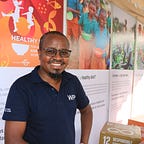Going the extra mile to protect victims of gender-based violence
In Kenya’s Dadaab refugee camps, survivors live in a protected area
The compound is hedged in with a double mesh wire fence on concrete posts, topped with razor wire. Each of the fences are then covered with an opaque mesh — keeping the prying eye out. There’s only one way in and out — a gate that is manned by a guard 24 hours, seven days a week.
This is a safe haven.
Currently, 32 people are living here; nine families in total — all women and children. Most of the women here are escaping extreme cases of domestic violence.
Selina (not here real name) is from South Sudan. She is a mother of five.
“My husband threatened to kill me. He inflicted serious wounds on me. Look at the scars on my arms,” she said. “Up to now, I live in fear. He is still pursuing us. He claims that I took his children away. Now he’s threatening to kill the children.”
Selina wipes her tearing eyes. I apologize, but she quickly brushes my apology aside and forces a smile as she regains her happy composure.
“We don’t get out of the compound. When I first sought refuge here, my three-year old daughter was only a couple of months old,” said Selina. “She’s never known any other home.”
Giving survivors a ‘normal life’
The women living in this centre have numerous physical and psychological scars. Winfred Mutheu is the matron. The women commonly call her ‘madam’.
“We’ve hosted many cases of domestic abuse, children that have been defiled by their own relatives, or women ostracized for marrying in the ‘wrong’ clan,” she said. “We try and give the families as close to a ‘normal life’ as we can.”
On top of undergoing counselling, the women are kept busy learning skills such as kitchen gardening, tailoring and fabric decoration through tie and dye.
“I keep myself busy in the garden. I’m growing okra and cowpeas,” explained Selina. “If I produce more than I require, madam takes the vegetables to the market and brings me the cash.”
The children go to ‘school’ in the compound where they have two teachers — a Kenyan national employed by the Danish Refugee Council (DRC) and one drawn from the refugee community.
At the moment, 15 pupils are attending school — consisting of just one classroom — where all learners meet. The teacher has to divide her attention and task the various grades simultaneously.
After school, children can watch television or go to the ‘park’ where swings and play toys are installed.
Access to food and services
The women living here mostly leave the compound only once a month to collect food from World Food Programme (WFP) distribution sheds. Their physical presence is required since the system uses biometric identification to determine who is eligible to receive food.
But because of their sensitive status, they are usually driven to and from the food-collection centre. At the food distribution point, they are given first priority.
Every time the women leave the compound — especially those of Somali origin — they cover their faces with the niqab veil — locally called ninja — which covers the whole face except the eyes.
In Dadaab camps, WFP gives assistance in the form of physical food and partly as Bamba Chakula cash transfers sent to refugees’ mobile telephones. Refugees have to go to the markets where they buy the food they want. WFP Kenya dubbed the voucher programme Bamba Chakula, literally
translating from Swahili to “Get your food”.
But the markets are extremely risky and difficult to control. The women in the safe haven can easily be followed and confronted.
“We decided that we will limit the chances of exposure by shopping for the mothers — rather than taking them to the market,” explained Winfred.
Safety first
Winfred collects an elaborate shopping list and sends it to a Bamba Chakula shopkeeper in the nearby market, who then gathers and packs the goods. Winfred, together with one of the women, boards a taxi and goes to the shop.
Winfred has a regular helper and an accountability partner — Aisha (not her real name). She is among those that have lived in the safe haven for many years.
Aisha helps Winfred to confirm the orders. In order to the pay the trader, Winfred has to carry the SIM cards and PIN numbers of the families. The safety of the families overrides the recommended practice for Bamba Chakula — not to share the PIN numbers.
Winfred and Aisha ensure that each gets food worth the value of their entitled cash transfer.
“Madam brings me all the things that I order. Mostly I buy beans, rice, sugar, wheat flour and onions,” said Selina.
Contact with the outside world for these women is limited, but many are grateful that they have found some peace.
“My greatest desire is to get a chance to bring up my children in a place where I don’t have to always look over my shoulder,” said Selina. “I’m living for my children. I will do anything to give them a good life.”
In 2017, WFP provided food and cash to refugees thanks to the generosity of donations from Canada, China, the European Civil Protection and Humanitarian Aid Operations (ECHO), Germany, Hungary, Japan, Saudi Arabia, Sweden, Switzerland, the United Kingdom and the United States.
